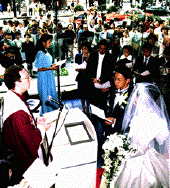 Science & Technology || Search || Back Numbers TONED-DOWN CEREMONIES:
 Couples are looking for new styles and venues for their weddings. (Photo: Kyodo) More and more young Japanese couples these days frown on expensive wedding ceremonies, and wedding costs appear to have topped out. A growing number of brides and grooms want their wedding ceremonies and receptions to stand apart from the cookie-cutter affairs offered by bridal companies. Furthermore, as the population of young people is declining and more of those young people are eschewing marriage the overall number of weddings has dropped. All of these trends mean that Japan's bridal industry will be the scene of a struggle for survival in the years to come, with companies fighting fiercely for slices of a shrinking pie. Marching down the Aisle in Style To accommodate this shift in consumer preferences, the number of retail shops specializing in wedding dresses is growing. There are now more than 70 such shops in Tokyo alone. Many of the shops offer imported apparel, which is relatively inexpensive. One retailer of imported wedding dresses offers its merchandise at an average price of 120,000 to 130,000 yen (1,000 to 1,100 dollars at 120 yen to the dollar). The retailer's catch phrase emphasizes that the average female office worker can acquire one of these gowns for just one month's salary. Another reason for the popularity of imported wedding gowns is their clean lines and simple designs. Many women say that if they find a design they like, they will even buy a used gown. Wedding Ceremonies Changing Too Of course, companies that operate wedding halls in Japan are not just sitting by idly and watching all of this happen; they are devising their own strategies for satisfying the needs of today's brides and grooms. These days, consumers of bridal services tend to be savvy; they peruse bridal magazines for ideas and decide for themselves what they feel is worth spending money on, and cut out any expenditures that they consider to be wasteful or merely for form's sake. Many people are particular about ambience-creating details like music and table settings. Accordingly, one well-known hotel now offers a customized wedding package, which allows couples to meet with the cook, the flower coordinator, and other staff and plan out the details of their wedding. Couples can decide what kind of food they would like, what color flowers they want at the tables, and so on. The golden combination of an economical price and freedom of choice have made this package very popular. Bridal Companies Fight for Survival However, wedding expenditures have stagnated since the bursting of Japan's economic bubble around 1990. According to one researcher, shopping for prestigious name-brand goods has given Japanese women an eye for quality and turned them into savvy consumers who are less willing to spend exorbitant sums on their weddings. Also, many hotels that were planned during the economic heyday of the bubble are now opening, and because corporate demand has plummeted, the hotels have to find other revenue sources. So they are putting more effort into weddings. This has led to price wars in some cases. Slump or no slump, the bridal industry still serves a 5-trillion-yen (42-billion-dollar) market. Although the wedding business has shrunk since its golden age, it is still very attractive. Many companies not previously involved in this business are now eagerly jumping in, adding themselves to the ranks of existing wedding halls and hotels. One major mail-order sales company has begun offering a wedding venue referral service and is trying to expand its sales of bridal goods. And one leading publisher has put out a CD recording of background music for weddings. Nonetheless, this market is waning. In 1996, when the second-generation baby boom was reaching marriageable age, a whopping 795,000 weddings were held. However, only 650,000 weddings are expected to take place in 2010. With the pie shrinking and consumers' tastes becoming increasingly fastidious, players in Japan's bridal industry are waging a desperate battle for survival. They will have to fight even harder in the years ahead.  Edited by Japan Echo Inc. based on domestic Japanese news sources. Articles
presented here are offered for reference purposes and do not necessarily
represent the policy or views of the Japanese Government.
Edited by Japan Echo Inc. based on domestic Japanese news sources. Articles
presented here are offered for reference purposes and do not necessarily
represent the policy or views of the Japanese Government.
|
